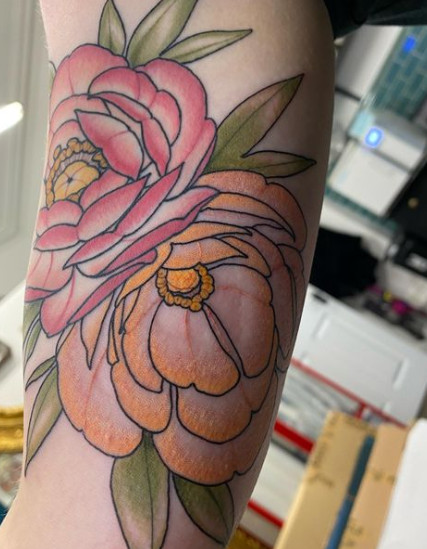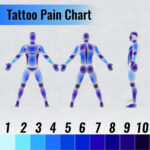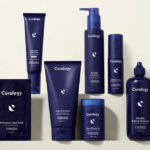Are you wondering, “Can You Tattoo Burned Skin?” The short answer is generally no. Tattooing over damaged skin, including sunburns and other burns, poses significant risks. At tattooat.com, we believe in prioritizing the health and safety of your skin while helping you achieve the beautiful body art you desire. Understanding the potential complications and proper healing processes is crucial for anyone considering a tattoo. If you are looking for tattoo inspiration, aftercare advice, or want to find reputable tattoo artists, make sure to check out our website.
Table of Contents
- Understanding Burned Skin and Tattooing
- Why Tattooing Burned Skin is Problematic
- Types of Burns and Tattoo Suitability
- The Healing Process of Burned Skin
- Risks of Tattooing Over Burned Skin
- Can You Tattoo on Sunburned Skin?
- Alternatives to Tattooing on Burned Skin
- Scar Tissue and Tattooing: What You Need to Know
- How to Protect Your Tattoos from Sunburn
- Frequently Asked Questions (FAQ)
1. Understanding Burned Skin and Tattooing
Burned skin, whether from the sun, heat, chemicals, or other sources, is damaged skin. Tattooing involves injecting ink into the dermis, the layer of skin beneath the epidermis. For a tattoo to heal properly and look its best, the skin must be healthy and intact. Tattooat.com emphasizes the importance of understanding skin health before undergoing any tattoo procedure. This involves knowing the structure of your skin and how it responds to trauma, such as burns.
The Structure of Skin
The skin consists of three main layers:
- Epidermis: The outermost layer, providing a protective barrier.
- Dermis: The middle layer, containing blood vessels, nerves, and hair follicles. This is where tattoo ink is deposited.
- Hypodermis: The deepest layer, composed of fat and connective tissue.
When skin is burned, these layers can be affected, leading to various complications if tattooed over.
2. Why Tattooing Burned Skin is Problematic
Tattooing burned skin is problematic due to the compromised state of the tissue. According to research from Portland State University’s Art Department, tattooing on damaged skin can lead to unpredictable ink distribution, increased risk of infection, and poor healing outcomes. Tattooat.com advises against it for several reasons:
- Compromised Skin Integrity: Burns damage the skin’s structure, making it difficult for the tattoo to heal properly.
- Increased Pain and Sensitivity: Burned skin is often more sensitive, leading to a more painful tattoo experience.
- Unpredictable Ink Absorption: Damaged skin may not absorb ink evenly, resulting in a patchy or distorted tattoo.
- Higher Risk of Infection: Burns compromise the skin’s protective barrier, increasing the risk of bacterial infections.
- Scarring: Tattooing over burned skin can exacerbate scarring and lead to keloid formation.
3. Types of Burns and Tattoo Suitability
Different types of burns affect the skin in varying degrees. The severity of the burn determines whether tattooing is a viable option in the future. Tattooat.com highlights the following types of burns:
First-Degree Burns
- Description: Affect only the epidermis, causing redness and pain.
- Tattoo Suitability: Tattooing is possible once the skin has fully healed, typically within a week.
Second-Degree Burns
- Description: Affect the epidermis and dermis, causing blisters and severe pain.
- Tattoo Suitability: Tattooing is possible after complete healing, which may take several weeks. Scarring is common.
Third-Degree Burns
- Description: Destroy the epidermis and dermis, affecting underlying tissues.
- Tattoo Suitability: Tattooing is generally not recommended due to extensive scarring and skin damage.
Fourth-Degree Burns
- Description: Extend beyond the skin, affecting muscle and bone.
- Tattoo Suitability: Tattooing is not possible due to the severity of the damage.
| Burn Type | Skin Layers Affected | Healing Time | Tattoo Suitability |
|---|---|---|---|
| First-Degree Burn | Epidermis | Approximately 1 week | Possible after full healing |
| Second-Degree Burn | Epidermis and Dermis | Several weeks | Possible after complete healing; scarring common |
| Third-Degree Burn | All skin layers | Months or longer | Generally not recommended |
| Fourth-Degree Burn | Extends to muscle/bone | Extensive medical care | Not possible |
4. The Healing Process of Burned Skin
Understanding the healing process of burned skin is essential before considering a tattoo. The healing time varies depending on the severity of the burn. Tattooat.com outlines the stages of healing:
- Inflammation: The initial response involves redness, swelling, and pain as the body begins to repair the damage.
- Proliferation: New skin cells form to close the wound. Collagen production increases, leading to scar formation.
- Remodeling: The scar tissue gradually softens and fades over time. This process can take months or even years.
Factors Affecting Healing
- Burn Severity: Deeper burns take longer to heal and are more likely to scar.
- Infection: Infections can delay healing and increase the risk of complications.
- Overall Health: General health and nutrition play a significant role in the healing process.
- Age: Younger skin tends to heal faster than older skin.
5. Risks of Tattooing Over Burned Skin
Tattooing over burned skin carries several risks that can compromise both the tattoo’s appearance and the health of your skin. According to Inked Magazine, the primary risks include infection, scarring, and unpredictable ink distribution. Tattooat.com details these risks:
Infection
Burned skin is more susceptible to bacterial infections due to the compromised protective barrier. Tattooing introduces additional trauma, further increasing the risk of infection. Symptoms of infection include:
- Increased pain and swelling
- Redness and warmth around the tattoo
- Pus or drainage
- Fever
Scarring
Tattooing can exacerbate scarring, especially if the burn has already resulted in scar tissue. This can lead to:
- Keloid Formation: Raised, thickened scars that extend beyond the original burn area.
- Hypertrophic Scars: Raised scars that remain within the boundaries of the burn.
- Poor Tattoo Appearance: Scar tissue can distort the tattoo design and affect ink absorption.
Unpredictable Ink Distribution
Burned skin may not absorb ink evenly, resulting in a patchy or faded tattoo. The ink can also spread or blur, leading to a distorted design. Factors contributing to unpredictable ink distribution include:
- Uneven Skin Texture: Scar tissue and damaged skin have an irregular texture that affects ink absorption.
- Altered Blood Flow: Burns can affect blood flow to the skin, impacting ink distribution.
- Compromised Skin Elasticity: Burned skin may lose elasticity, making it difficult for the tattoo to heal properly.
Increased Pain and Discomfort
Burned skin is often more sensitive, making the tattooing process more painful. The added trauma can also lead to prolonged discomfort and healing time. This increased sensitivity is due to the damage to nerve endings in the skin.
Allergic Reactions
Damaged skin is more prone to allergic reactions to tattoo ink. Allergic reactions can manifest as:
- Itching
- Rash
- Swelling
- Redness
6. Can You Tattoo on Sunburned Skin?
No, tattooing on sunburned skin is highly discouraged. Sunburn is a first-degree burn that damages the epidermis, making the skin inflamed, sensitive, and compromised. According to tattoo artist Hannah Gehrke, “Sunburn is skin damage from overexposure to UV rays, and the last thing you want to do is tattoo over it.” Tattooat.com emphasizes the following reasons to avoid tattooing on sunburned skin:
- Inflammation and Sensitivity: Sunburned skin is already inflamed and painful. Tattooing will further irritate the skin, increasing discomfort and the risk of complications.
- Poor Ink Absorption: Sunburned skin may not absorb ink evenly, resulting in a patchy or faded tattoo.
- Increased Risk of Infection: Sunburn compromises the skin’s protective barrier, making it more susceptible to infection.
- Peeling Skin: As sunburned skin heals, it peels. Tattooing on peeling skin is difficult because the stencil won’t adhere properly.
- Fading: Tattoos on sunburned skin can fade and result in a patchy look.
How Long After Sunburn Can You Get a Tattoo?
It’s best to wait until the sunburn has completely healed before getting a tattoo. This means the skin should be free of redness, inflammation, and peeling. Generally, this takes about one to two weeks. However, deeper sunburns may require longer healing times. Hannah Gehrke advises ensuring the skin is fully back to its normal state before considering a tattoo.
Treating Sunburn Before Tattooing
If you have a sunburn, focus on treating it to promote healing. Recommended treatments include:
- Cool Compresses: Apply cool, damp cloths to the affected area.
- Moisturizer: Use a gentle, fragrance-free moisturizer to hydrate the skin.
- Aloe Vera: Apply aloe vera gel to soothe the skin and reduce inflammation.
- Avoid Sun Exposure: Stay out of the sun to prevent further damage.
- Hydration: Drink plenty of water to keep your skin hydrated.
7. Alternatives to Tattooing on Burned Skin
If you have burned skin that you wish to cover with a tattoo, there are alternative approaches to consider. Tattooat.com recommends the following:
Medical Treatments
- Laser Therapy: Can help reduce scarring and improve skin texture.
- Dermabrasion: Removes the top layers of skin to smooth out scars.
- Skin Grafts: In severe cases, skin grafts may be necessary to replace damaged tissue.
Waiting for Complete Healing
Allowing the skin to heal completely is the best approach. This may take months or even years, depending on the severity of the burn. Once the skin has healed, consult with a tattoo artist experienced in tattooing over scar tissue.
Tattoo Placement
Consider placing the tattoo in an area that is not affected by the burn. This allows you to get a tattoo without risking complications on damaged skin. Work with your artist to find a design and placement that you will be happy with.
Consultation with a Tattoo Artist
A consultation with a skilled tattoo artist is crucial. They can assess the condition of your skin and advise you on the best course of action. Look for artists who have experience with scar cover-ups and are knowledgeable about skin health. At tattooat.com, you can find reputable artists in your area.
8. Scar Tissue and Tattooing: What You Need to Know
Tattooing over scar tissue is a complex process that requires expertise and careful consideration. Scar tissue differs from normal skin in several ways:
- Collagen Structure: Scar tissue has a disorganized collagen structure, making it less elastic and more rigid.
- Blood Flow: Blood flow is often reduced in scar tissue, affecting ink absorption and healing.
- Nerve Sensitivity: Scar tissue may have altered nerve sensitivity, leading to increased pain or numbness.
Considerations for Tattooing Over Scar Tissue
- Type of Scar: Different types of scars respond differently to tattooing. Flat, well-healed scars are generally easier to tattoo over than raised or keloid scars.
- Age of Scar: Older scars are typically easier to tattoo over than newer scars. It’s best to wait at least one year after the burn has healed before considering a tattoo.
- Artist Experience: Choose an artist with experience in tattooing over scar tissue. They will have the knowledge and skills to navigate the challenges of tattooing on damaged skin.
Techniques for Tattooing Over Scar Tissue
- Needle Selection: Artists may use different needle configurations to work with scar tissue.
- Ink Selection: Certain inks may be better suited for scar tissue than others.
- Pressure and Depth: Adjusting the pressure and depth of the needle is crucial to ensure proper ink deposition.
9. How to Protect Your Tattoos from Sunburn
Protecting your tattoos from sunburn is essential to prevent fading, distortion, and other damage. Tattooat.com recommends the following tips:
- Apply Sunscreen: Use a broad-spectrum sunscreen with an SPF of 50 or higher. Apply liberally to all exposed tattoos, especially during peak sun hours.
- Wear Protective Clothing: Cover your tattoos with clothing, such as long sleeves or pants, when possible.
- Seek Shade: Avoid prolonged sun exposure by seeking shade under trees, umbrellas, or other shelters.
- Avoid Tanning Beds: Tanning beds emit harmful UV rays that can damage your tattoos.
- Stay Hydrated: Drinking plenty of water helps keep your skin healthy and hydrated, which can protect your tattoos.
Sunscreen Recommendations
- Broad-Spectrum: Protects against both UVA and UVB rays.
- SPF 50 or Higher: Provides adequate protection against sunburn.
- Water-Resistant: Remains effective after swimming or sweating.
- Fragrance-Free: Reduces the risk of skin irritation.
Treating Sunburn on Tattoos
If your tattoo does get sunburned, follow these steps:
- Cool the Skin: Apply cool compresses to the affected area.
- Moisturize: Use a gentle, fragrance-free moisturizer to hydrate the skin.
- Avoid Irritants: Do not use harsh soaps, scrubs, or exfoliants.
- Stay Hydrated: Drink plenty of water to help your skin heal.
- Seek Medical Attention: If the sunburn is severe or shows signs of infection, consult a doctor.
10. Frequently Asked Questions (FAQ)
Q1: Is it safe to tattoo over a minor burn?
A: No, it is generally not safe to tattoo over any burn, even a minor one. Burned skin is damaged and more susceptible to infection, poor ink absorption, and scarring.
Q2: How long should I wait after a burn before getting a tattoo?
A: You should wait until the burn has completely healed, which may take several months or even years, depending on the severity. Consult with a tattoo artist experienced in tattooing over scar tissue.
Q3: Can tattooing help cover up burn scars?
A: Yes, tattooing can help cover up burn scars, but it requires careful planning and an experienced artist. The results may vary depending on the type and severity of the scar.
Q4: What type of tattoo is best for covering burn scars?
A: The best type of tattoo for covering burn scars depends on the individual case. Generally, designs with intricate details, shading, and color variations are more effective at camouflaging scars.
Q5: Can I use numbing cream before getting a tattoo on burned skin?
A: Numbing creams may help reduce pain, but it’s essential to consult with your tattoo artist before using them. Some numbing creams can affect the skin’s texture and ink absorption.
Q6: What are the signs of infection after tattooing over burned skin?
A: Signs of infection include increased pain, swelling, redness, warmth, pus or drainage, and fever. Seek medical attention immediately if you experience any of these symptoms.
Q7: Can I get a tattoo if I have a history of keloid scarring?
A: If you have a history of keloid scarring, you are at higher risk of developing keloids after tattooing. Consult with a dermatologist and an experienced tattoo artist before proceeding.
Q8: How can I find a tattoo artist experienced in scar cover-ups?
A: You can find experienced tattoo artists by searching online directories, asking for recommendations from friends or family, or visiting tattoo conventions. Look for artists with a portfolio of scar cover-up tattoos. At tattooat.com, we have a database of artists that can do scar cover-ups.
Q9: What is the cost of tattooing over burn scars?
A: The cost of tattooing over burn scars varies depending on the size and complexity of the tattoo, as well as the artist’s rates. Scar cover-up tattoos often require more time and skill, so they may be more expensive than regular tattoos.
Q10: Can I get laser tattoo removal on tattooed burn scars?
A: Yes, laser tattoo removal is possible on tattooed burn scars, but it may require more sessions and the results may vary. Consult with a qualified laser tattoo removal specialist.
At tattooat.com, we believe in providing you with the information and resources you need to make informed decisions about your body art. Whether you’re looking for inspiration, aftercare advice, or reputable tattoo artists, we’re here to support you every step of the way.
Ready to explore the world of tattoos? Visit tattooat.com today to discover stunning designs, find talented artists, and learn everything you need to know about getting the perfect tattoo.
Address: 1825 SW Broadway, Portland, OR 97201, United States
Phone: +1 (503) 725-3000
Website: tattooat.com
 Pink and yellow peony tattoos on arm
Pink and yellow peony tattoos on arm

